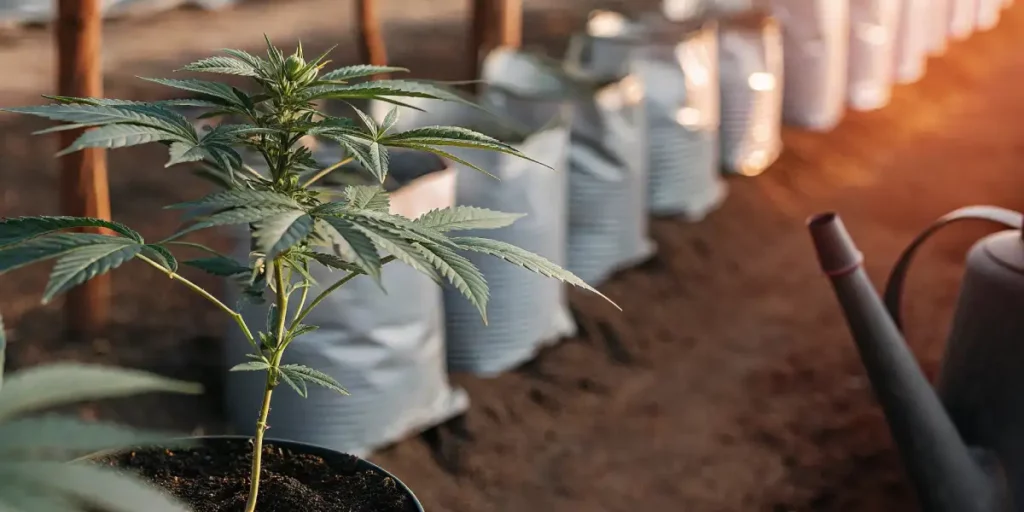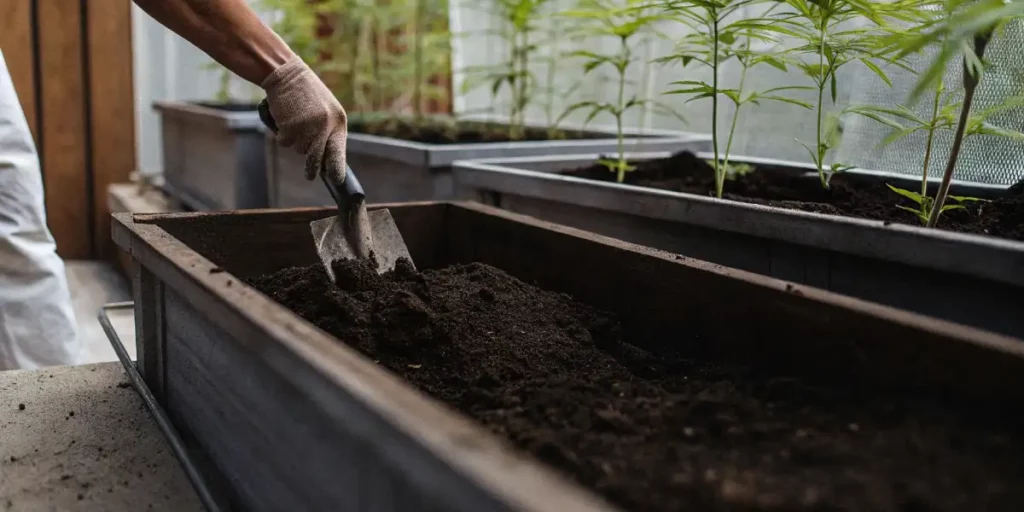Growing cannabis outdoors can be a rewarding experience, but achieving a high yield requires knowing outdoor cannabis nutrients. The soil, water, and air provide the basic building blocks, but additional nutrients are vital for maximizing growth. The right nutrients can enhance plant health and boost yield. They’re the difference between a good crop and a great one.
Different stages of growth require different nutrients. For instance, during the vegetative stage, nitrogen is crucial. It’s like giving your plants a protein shake, helping them grow big and strong. Potassium and phosphorus are just as important during flowering, ensuring robust buds. With the proper nutrient balance, your plants can thrive.
Many growers are turning to organic solutions made from natural ingredients that are gentle on the environment. These provide the same benefits as synthetic nutrients but are kinder to the earth. If you’re a beginner, consider starting with organic options—they’re ideal for learning and support healthy plant development.
Choosing the Right Nutrient Solution
Selecting the right outdoor cannabis nutrients can feel overwhelming, but it doesn’t have to be. It’s about matching the nutrients to the growth stage of your plants. A balanced nutrient mix will include nitrogen, phosphorus, and potassium, often referred to as N-P-K. These are essential for plant growth and development.
For first-time growers, sticking to a simple nutrient schedule is key. Too much or too little can harm your plants. Start with a basic nutrient solution and adjust as needed. Strains like Gorilla Glue 4, available at Global Green Genetics, are forgiving and can handle variations in nutrient levels, making them ideal for beginners.
Knowing the specific needs of your cannabis strain is also critical when selecting nutrients. Some strains might prefer a higher nitrogen concentration during the vegetative stage, while others thrive on a phosphorus-rich diet during flowering. Researching your strain’s preferences can provide insights into the best nutrient solutions for your plants.
Additionally, environmental factors such as climate and soil type can impact how plants absorb nutrients. Growers should consider these factors when selecting nutrients, as they can influence nutrient uptake and effectiveness. Tailoring your nutrient solution to both your strain and environment can significantly enhance plant growth and yield.
Organic vs Synthetic Nutrients
Organic outdoor cannabis nutrient solutions are growing in popularity. They are derived from natural sources such as compost, bone meal, and fish emulsion. They release nutrients slowly, reducing the risk of nutrient burn. These solutions are also beneficial for the soil, improving its quality over time.
Synthetic nutrients, on the other hand, offer precise control over what your plants receive. They are formulated for specific stages of growth, providing a quick nutrient boost. While effective, they can sometimes lead to nutrient buildup in the soil, which might require flushing.
Another advantage of organic outdoor cannabis nutrient solutions is their ability to improve the overall ecosystem of your garden. By enriching the soil with organic matter, they foster beneficial microbial activity, which can enhance nutrient availability and plant resilience. This holistic approach often leads to healthier plants with better resistance to diseases and pests.
On the other hand, synthetic nutrients are favored by growers seeking rapid growth and precise control over nutrient levels. They are particularly useful in addressing specific deficiencies quickly. However, careful monitoring is required to prevent overfeeding and potential nutrient lockout. Finding a balance between the two can optimize plant health and yield.

Outdoor Cannabis Nutrient Schedules
Developing an outdoor cannabis nutrient schedule for high yield is crucial. This schedule outlines when and how much to feed your plants. During the early vegetative stage, focus on high nitrogen levels. As the plant transitions to flowering, increase phosphorus and potassium.
Most growers use a weekly feeding schedule. This approach allows for adjustments based on how the plants respond. If you notice yellowing leaves, it might indicate a lack of nitrogen. Adjust your schedule accordingly. Strains like Northern Lights, available at Global Green Genetics, thrive with a consistent feeding routine.
An outdoor cannabis nutrient schedule for high yield should also consider weather patterns and seasonal changes. For instance, increased rainfall may necessitate adjustments in feeding frequency to prevent nutrient leaching. Conversely, during dry spells, supplemental watering with nutrient solutions can ensure consistent nutrient availability.
Regular monitoring is essential to evaluate the effectiveness of your nutrient schedule. Keep a journal to track nutrient applications, plant growth, and any signs of deficiencies or excesses. This data-driven approach can help refine your schedule over time, leading to optimized growth and higher yields.
Feeding Techniques
Knowing how to use outdoor cannabis nutrients effectively is as important as choosing the right ones. One method is top dressing, where nutrients are applied directly to the soil. This technique is simple and effective, especially for organic nutrients.
Another technique is foliar feeding, which involves spraying a nutrient solution directly onto the leaves. This provides nutrients quickly, as the leaves absorb them directly. It’s useful for addressing deficiencies but should be done sparingly to avoid leaf burn.
Soil drenches are also popular. This involves mixing nutrients with water and applying it to the soil. It ensures even distribution and is effective for both organic and synthetic nutrients. Whichever method you choose, ensure even coverage to prevent nutrient imbalances.
When deciding how to use nutrients effectively, consider the growth stage and specific needs of your plants. For example, foliar feeding can be particularly beneficial during the vegetative stage when rapid growth demands increased nutrient uptake. Meanwhile, soil drenches are ideal during flowering to support robust bud development.
Top Nutrients for Flowering Stage
The flowering stage is when your plants develop buds, and the right outdoor cannabis nutrients are crucial. Phosphorus and potassium are the stars here. They promote bud development and increase potency. During this stage, calcium and magnesium also play a role in strengthening cell walls and improving photosynthesis.
Liquid fertilizers are often recommended for the flowering stage. They allow for precise control and can be easily adjusted to meet the plant’s needs. Many growers find success with a combination of liquid and granular nutrients, ensuring a steady nutrient supply.
Using the right nutrients during the flowering stage can make a significant difference in the quality and quantity of your harvest. Nutrients rich in phosphorus stimulate flowering and enhance the density of buds, while potassium enhances overall plant health and resistance to stress.
Calcium and magnesium are also vital during flowering, as they support cellular function and nutrient absorption. Ensuring your plants receive adequate amounts of these secondary nutrients can prevent common issues like blossom end rot and nutrient lockout, leading to healthier, more productive plants.
Strains and Nutrient Needs
Different strains have unique nutrient needs. For example, Indica strains like Gorilla Glue 4 often require more potassium during flowering. Sativa strains, on the other hand, may need more nitrogen during vegetative growth. Understanding your strain’s needs can help tailor your nutrient schedule for maximum yield.
Hybrids like Blue Dream combine characteristics of both Indica and Sativa. This affects their nutrient requirements. They often need a balanced approach, with adjustments based on growth stage and environmental conditions. Monitoring your plants regularly will help you make these adjustments.
When considering the best outdoor cannabis nutrients for beginners, it’s important to understand the specific nutrient requirements of the strains you’re growing. While some strains are more forgiving, others may be more sensitive to nutrient levels, requiring careful management to avoid deficiencies or toxicities.
Experimenting with different strains can provide valuable insights into their nutrient preferences. By observing how each strain responds to your chosen nutrient regimen, you can fine-tune your approach to optimize growth and yield. This hands-on learning process is essential for mastering the art of outdoor cannabis cultivation.

FAQs of outdoor cannabis nutrients
What are the best outdoor cannabis nutrients for beginners?
For beginners, simplicity is key. Start with a balanced nutrient mix that covers the basics: nitrogen, phosphorus, and potassium. Organic options are often recommended as they are forgiving and less likely to cause nutrient burn. As you gain experience, you can experiment with more complex mixes.
Strains like Gorilla Glue 4 from Global Green Genetics are ideal for beginners. They are resilient and can thrive even if the nutrient balance isn’t perfect. Focus on learning the basics and gradually refine your approach as you become more confident in your growing skills.
Choosing the best nutrients for beginner growers involves selecting products that are easy to use and less prone to causing nutrient burn. Many beginner-friendly nutrient kits come with straightforward instructions and pre-measured doses, reducing the risk of over or underfeeding.
Starting with organic outdoor cannabis nutrient solutions can also provide a solid foundation for novice growers, as they tend to be more forgiving and improve soil health over time. As your experience grows, you can explore new nutrient formulations and techniques to further enhance your growing results.
How can I use outdoor cannabis nutrients effectively?
The key to effective nutrient use is consistency. Follow a feeding schedule and monitor your plants closely. Adjust the nutrient mix based on the plant’s growth stage and any visible signs of nutrient deficiencies or excesses. This proactive approach ensures your plants receive what they need when they need it.
Experiment with different application methods, such as top dressing and foliar feeding, to see what works best for your setup. Strains like Northern Lights are known for their responsiveness to well-planned feeding schedules, making them a great choice for refining your technique.
Knowing how to use outdoor cannabis nutrients effectively involves not only choosing the right products but also applying them at the right times. Regularly check your plants for signs of nutrient stress, such as yellowing leaves or stunted growth, and adjust your regimen accordingly to prevent long-term issues.
Integrating good cultural practices, such as maintaining optimal soil pH and ensuring adequate watering, can also enhance nutrient uptake. By creating a balanced environment, you can maximize the effectiveness of your nutrient solutions and support healthy, vigorous plant growth.
Are organic outdoor cannabis nutrient solutions effective?
Yes, organic nutrient solutions are highly effective and provide numerous benefits. They improve soil health, promote sustainable growing practices, and reduce the risk of chemical buildup. While they may take longer to show results compared to synthetic options, the benefits to plant health and the environment are significant.
Organic solutions are especially beneficial for growers who prioritize eco-friendly practices. Strains like Blue Dream respond well to organic nutrients, allowing growers to achieve impressive yields while maintaining a commitment to sustainability.
Organic outdoor cannabis nutrient solutions are also praised for enhancing the natural flavor and aroma of the cannabis. By using organic inputs, growers can produce cleaner, more aromatic buds, which are highly sought after by connoisseurs and consumers alike.
Furthermore, organic nutrients contribute to long-term soil health, creating a more sustainable growing environment. Over time, this can lead to improved plant resilience and higher yields, making organic solutions an attractive choice for environmentally conscious growers.
What is a good outdoor cannabis nutrient schedule for high yield?
A good nutrient schedule is tailored to the plant’s growth stages. During the vegetative stage, focus on nitrogen-rich nutrients. As the plant enters the flowering stage, shift to phosphorus and potassium to support bud development. A weekly feeding schedule allows for adjustments based on plant response.
Monitor your plants regularly and adjust the schedule as needed. Consistency and observation are key to achieving high yields. Strains like Northern Lights can benefit significantly from a well-planned nutrient schedule, helping you maximize your outdoor grow.
Developing an outdoor cannabis nutrient schedule for high yield involves knowing the specific needs of your plants at each stage of growth. By tailoring nutrient applications to the plant’s lifecycle, you can ensure they receive the right balance of nutrients to maximize growth and bud production.
Record-keeping is an essential component of a successful nutrient schedule. By noting application dates, nutrient formulations, and plant responses, you can refine your approach over time. This attention to detail helps optimize plant health and boosts overall yield.
Which are the top outdoor cannabis nutrients for the flowering stage?
During the flowering stage, nutrients high in phosphorus and potassium are essential. These elements support bud development and increase potency. Calcium and magnesium are also important, as they strengthen the plant’s structure and improve photosynthesis.
Liquid fertilizers are often preferred for their ease of use and ability to provide precise nutrient levels. Combining liquid and granular fertilizers can ensure a consistent nutrient supply. Strains like Gorilla Glue 4 benefit from a carefully balanced nutrient mix during this critical stage.
Besides to phosphorus and potassium, micronutrients such as zinc, iron, and manganese can play a crucial role during the flowering stage. These elements support enzymatic functions and overall plant metabolism, contributing to the development of dense, potent buds.
Choosing the top outdoor cannabis nutrients for flowering stage also involves considering the delivery method. Liquid feeds can provide a rapid nutrient boost, while slow-release granular options offer sustained nutrition. A strategic combination of both can enhance flowering outcomes and increase yield potential.





